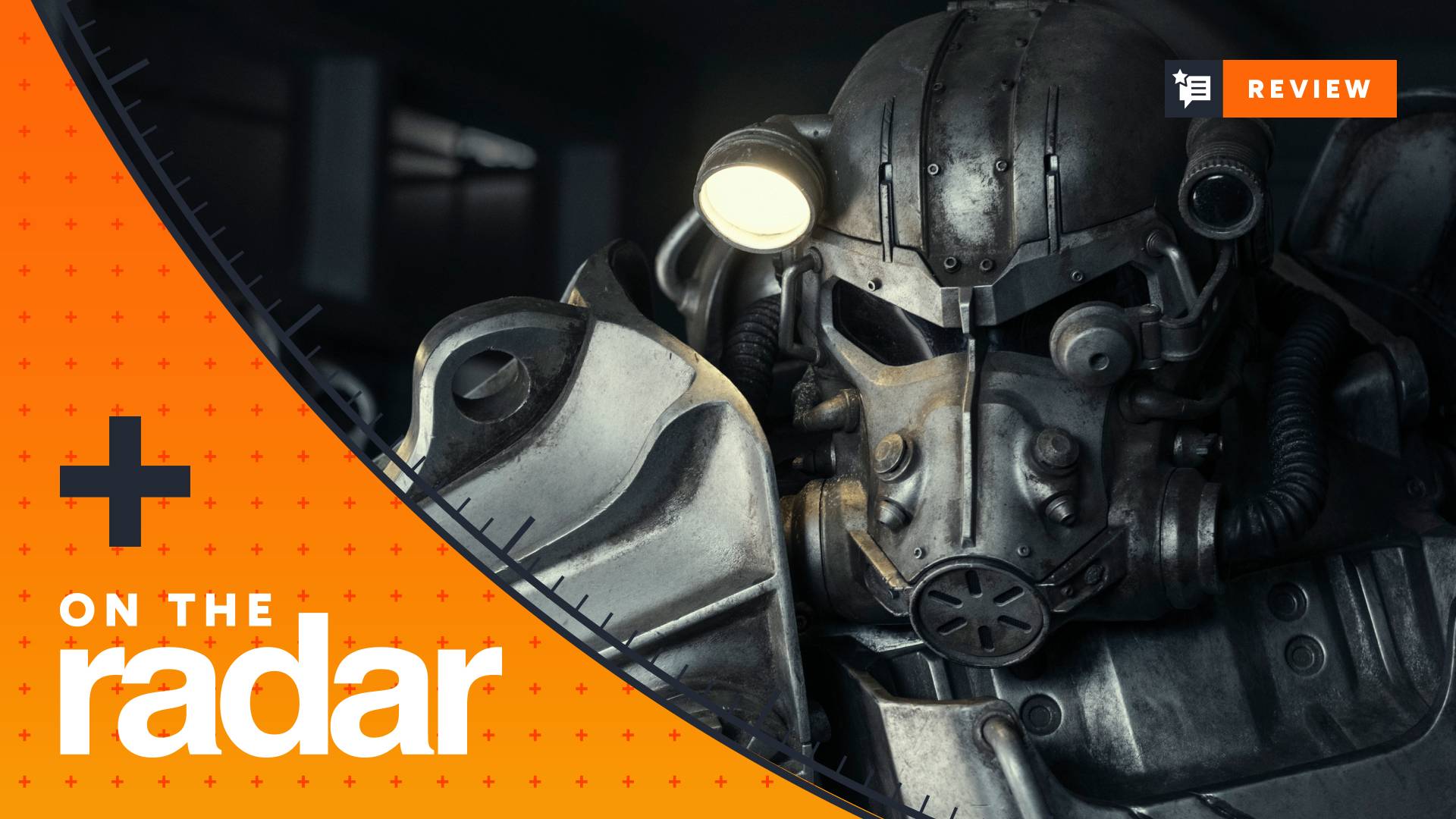GamesRadar+ Verdict
It's not the cheapest, but it's far from the most expensive and considering the price you're paying the HP Omen Max 16 puts on one hell of a show. Powerful but streamlined, exciting but understated - the Max has plenty going for it, just don't hammer those keys too hard or unplug the power cable.
Pros
- +
Excellent performance
- +
Streamlined design
- +
Crisp white chassis
- +
Vibrant RGB
- +
Smart port placements
Cons
- -
Low battery life
Why you can trust GamesRadar+
September 25, 2025 - This review has been updated with additional context surrounding more recently reviewed gaming laptops, most notably the similarly priced Alienware 16 Area-51 and cheaper Lenovo Legion 5 Gen 10. All new discussion has been separated from original words below, and my final score and recommendation remains the same.
The HP Omen Max 16 is everything I wanted it to be. I'm a disillusioned fan of this range, having landed with a GTX 1050 Omen as my first ever gaming laptop before falling out of love with its fairly janky releases in the years following. It's had some wins in the last few years, even if the more recent HP Omen 17 was fairly uninspired, but 2025's release changes everything.
This is a powerful machine, but it's wrapped up in a slick, streamlined chassis that keeps things slim while still hiding enough space to let those components reach their full potential. With a price tag that holds its own against the rest of the market and a wealth of additional features packed in, this is one of the best gaming laptop I've tested in 2025 so far.

The first gaming laptop I ever had was an HP Omen and I've been keen for this line to up its game ever since. Since those early days, I've personally reviewed over 50 gaming laptops, including the Max's main competition, the Razer Blade 16. I personally prefer 16-inch machines, and prioritize a value-rich price/performance ratio over complete raw power in my own purchases. When I'm not testing new gaming laptops, my current rig is an RTX 4070 Razer Blade 14.
| Header Cell - Column 0 | Tested | Also Available |
|---|---|---|
Price | $3,299.99 / £2,999 | $2,299.99 - $3,599.99 / £2,399 - £3,999 |
Display | 16-inch 2560 x 1600 IPS at 240Hz | 16-inch 1920 x 1200 IPS at 165Hz | 16-inch 2560 x 1600 OLED at 240Hz |
Processor | Intel Core Ultra 9 275HX | Intel Core Ultra 7 255HX | AMD Ryzen AI 7 H 350 | AMD Ryzen AI 9 HX 375 |
GPU | Nvidia GeForce RTX 5080 | RTX 5070 | RTX 5070 Ti | RTX 5090 |
RAM | 32GB DDR5-5600MT/s | 16GB | 64GB |
Storage | 1TB PCle Gen4 NVMe M.2 SSD | 512GB | 2TB |
Connectivity | WiFi 7, Bluetooth 5.4 | - |
Ports | 2x USB Type-A, 2x Thunderbolt 4 USB-C (Power Delivery 3.1, DisplayPort 2.1), 1x HDMI 2.1, 3.5mm audio, 1x RJ-45 | 2x USB Type-A, 2x USB Type-C (Power Delivery 3.1, DisplayPort 2.1), 1x HDMI 2.1, 3.5mm audio, 1x RJ-45 |
Dimensions | 14.04 x 10.59 x 0.98 inch | - |
Weight | 6.1lbs | 5.5lbs |
Configurations
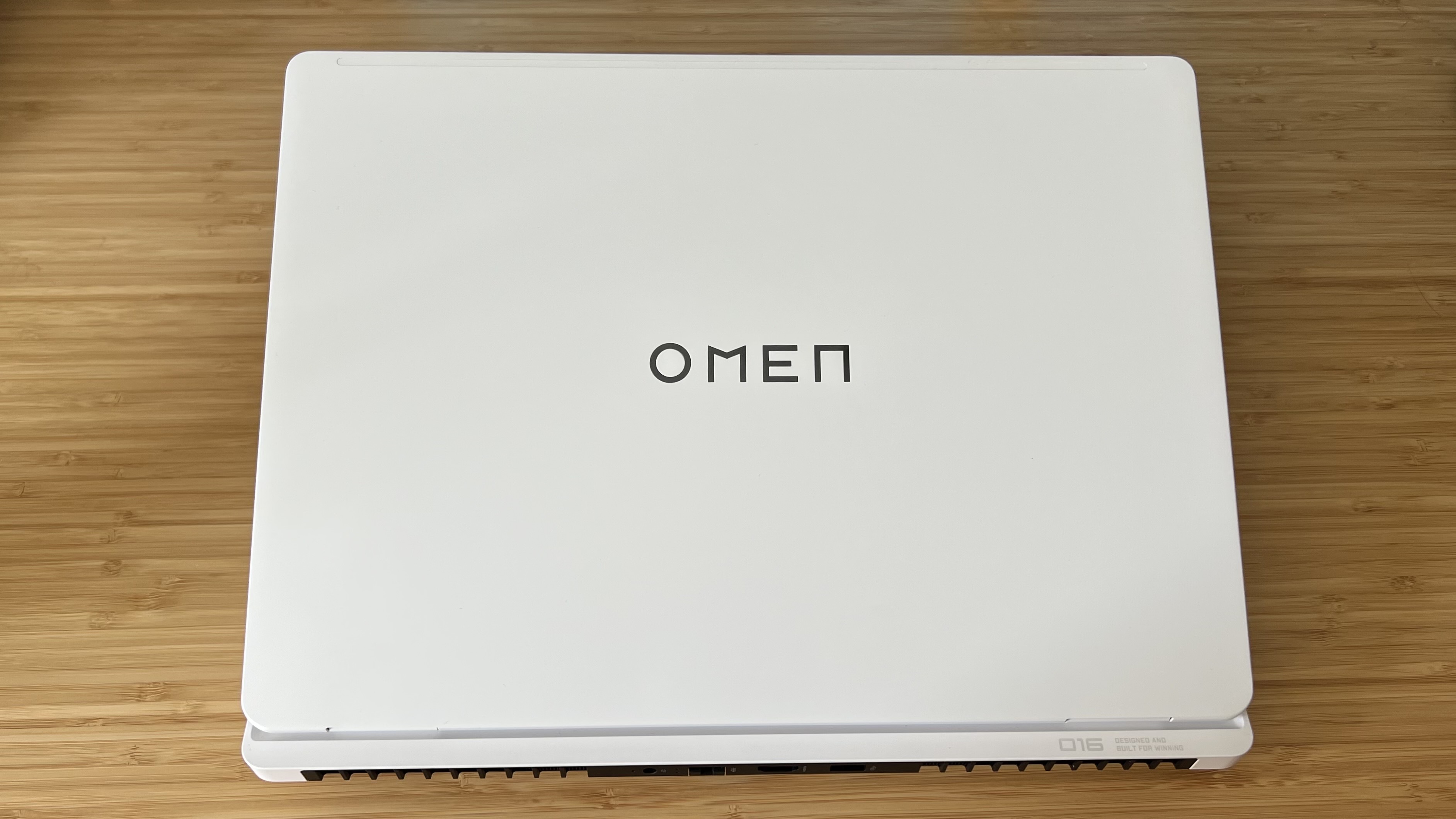
HP has gone wide with its configuration options for the Omen Max 16, spanning the mid to high range in its GPU offerings and splitting devices across both Intel and AMD. We kick off at an RTX 5070 with Intel's Core Ultra 7 255HX processor for a $2,299.99 / £2,399.99 base price, soaring up to the full-whack RTX 5090 and Intel Core Ultra 9 275HX / AMD Ryzen AI 9 HX 375, high-end models costing around $3,600 / £4,000.
The model I'm testing packs an RTX 5080 GPU and Intel Core Ultra 9 processor, with 32GB RAM and a 1TB SSD into a $3,299.99 / £2,999 price tag. That's not cheap, but it's certainly not as expensive as some.
An RTX 5080 configuration of the 2025 Razer Blade 16 comes with a slightly weaker AMD Ryzen AI 9 365 processor and equal RAM / storage amounts for $3,499.99 (though with an upgrade to an OLED display). The Alienware 16 Area-51 that's patiently waiting its turn on my testing bench goes for $3,349.99 with the same specs as well.
The Asus ROG Strix G16 lowers the price tag to $2,899.99, while the Asus ROG Strix Scar 16 halves your RAM (but doubles your storage) for the same $3,299.99 MSRP.
That means the HP Omen Max 16 sits squarely in the middle for an RTX 5080 rig, though with the additional benefits of cheaper configurations that others may drop.
Weekly digests, tales from the communities you love, and more
There's one difference between this rig and others in its price league that makes the HP Omen Max 16 stand just a little taller. It's on sale far more regularly. Even as I'm writing this review, the configuration I'm testing has dropped from $3,299.99 to $2,599.99 and it's far from the first time I've seen savings here.
Design
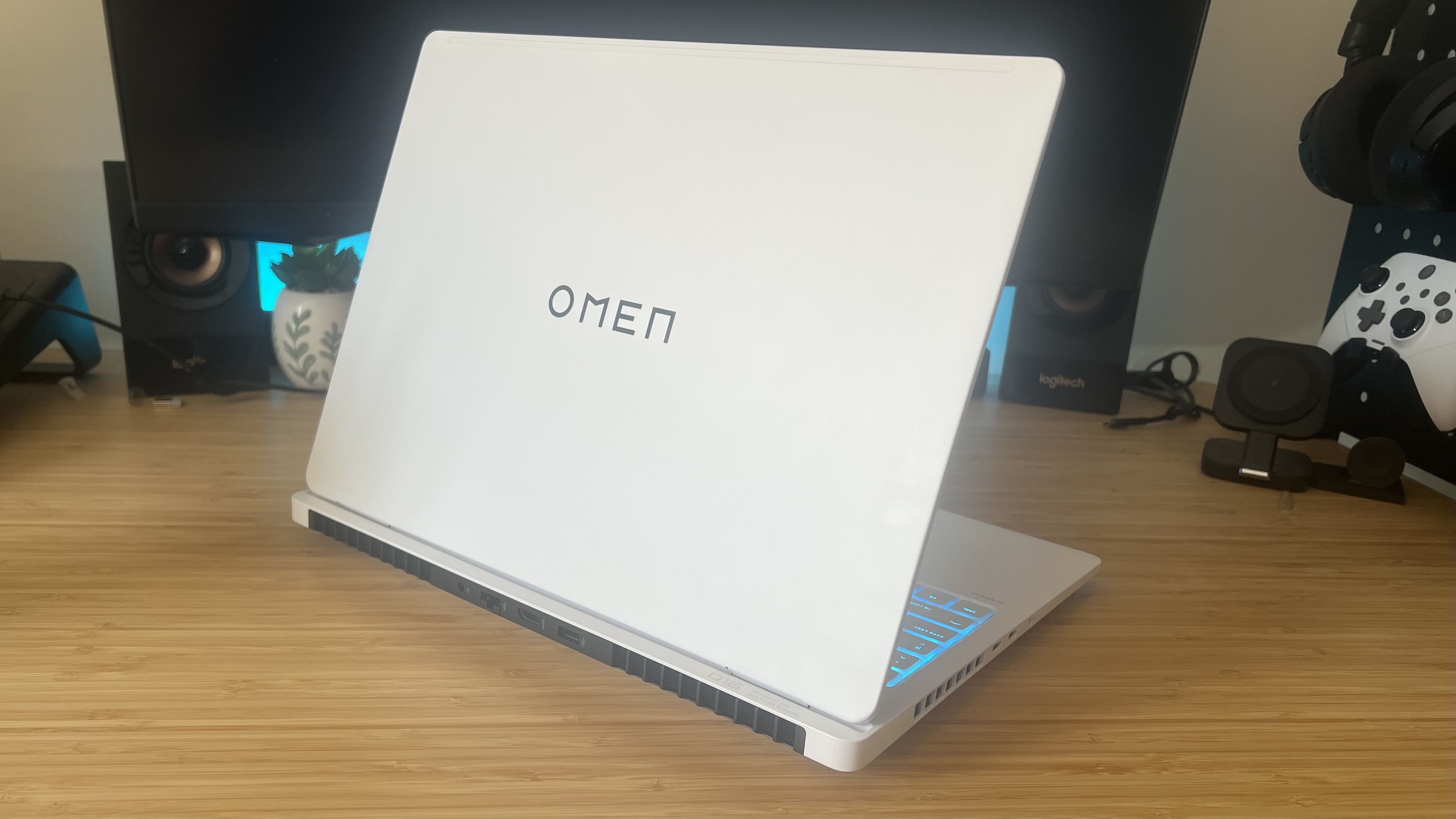
I unbox a lot of gaming laptops, but every now and then I unsleeve a machine that makes me audibly coo. The HP Omen Max's crisp white chassis and soft-touch coating was love at first sight.
That white has stayed resistant to stains and scuffs in the time I've been carting it around and the lighter tone means fingerprints aren't an issue either. The main chassis' clean lines and tapered lip design makes a statement without being too bold - that's where the RGB comes in.
HP has outfitted the Omen Max 16 with a strikingly vibrant set of LEDs under the main keyboard, as well as a light strip that casts a clean glow on the surface below. It's not quite as strong as that of the Asus ROG Strix Scar 18 or the Asus ROG Strix G16, but it still creates a slick floating effect.
This smart form factor means the Omen offers the best of both worlds. It's easy enough to throw into a backpack and doesn't overwhelm a desk setup like chunkier models, but there's still enough space to let those components breathe. Rather than the boxy, square designs of the best Razer laptops or the Asus ROG Zephyrus G16, the Max 16 maintains a 'gaming laptop' shape but with a slimmer profile overall.
The back panel is also free from larger RGB panels or garish stamps, with a classy Omen logo stamped into the lid and covered with a sophisticated glossy effect. Inside, we do have a little iconography going on, but it's restricted to a light gray '016' in the lower right corner and a 'Max' stamp on the opposite side. Those dotted grills running along the top look very HP as well, keeping space for a speaker without overwhelming the internal design.
I've now had my hands on the Alienware 16 Area-51, and its chunkier design, extension of the cooling shelf to the rear, and relatively redundant cooling window cement the HP Omen Max's design as one of my absolute favorites.
Display
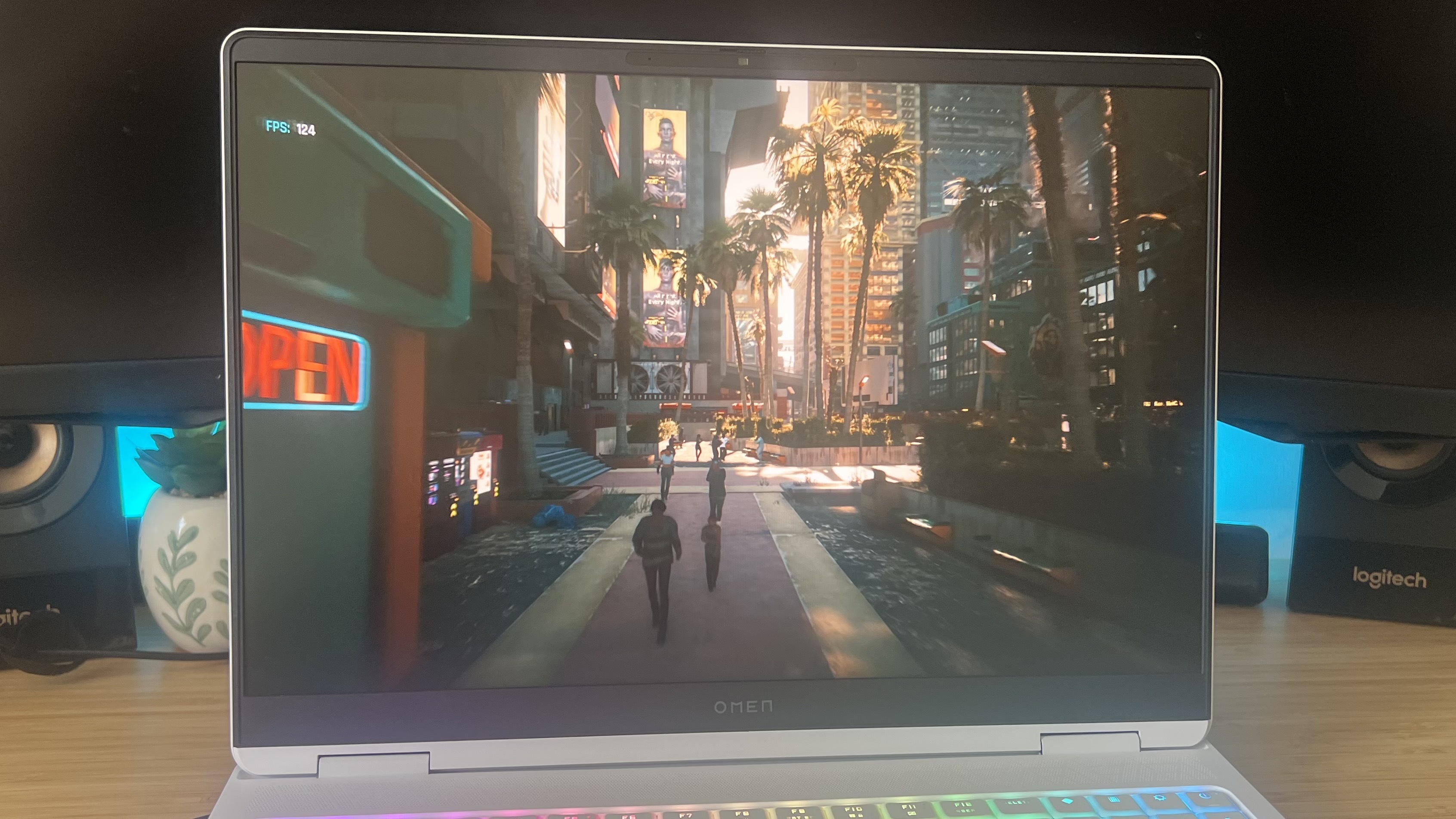
I'll say it now, Razer and the best Asus gaming laptops have an edge on their displays. The HP Omen Max 16 is configurable with an OLED panel (though there are fewer of those options on the shelves at the moment) but I've been testing the standard IPS. There's a drop in vibrancy and contrast compared to more premium display options out there, but this is still a pretty face.
It doesn't quite pack the same punch as the IPS featured on the Asus ROG Strix G16, which does a particularly good job of keeping its color contrast up without an OLED screen, but there's still a nice amount of energy here. Color reproduction is well balanced with more naturally vivid scenes benefitting from a satisfying injection of power.
HP still maintains its upper hand against the competition, as OLED options are available, and the IPS screen I tested was still impressive. It's just not quite the jewel in the Max's crown.
The Alienware 16 Area-51 features an IPS screen like the HP Omen Max 16 I tested. It's far from as punchy, though - HP wins in the screen arena here. However, if you are looking to both keep costs down and secure that OLED display, the Lenovo Legion 5 Gen 10 surprised me with its luxury panel on a more affordable chassis.
Ports
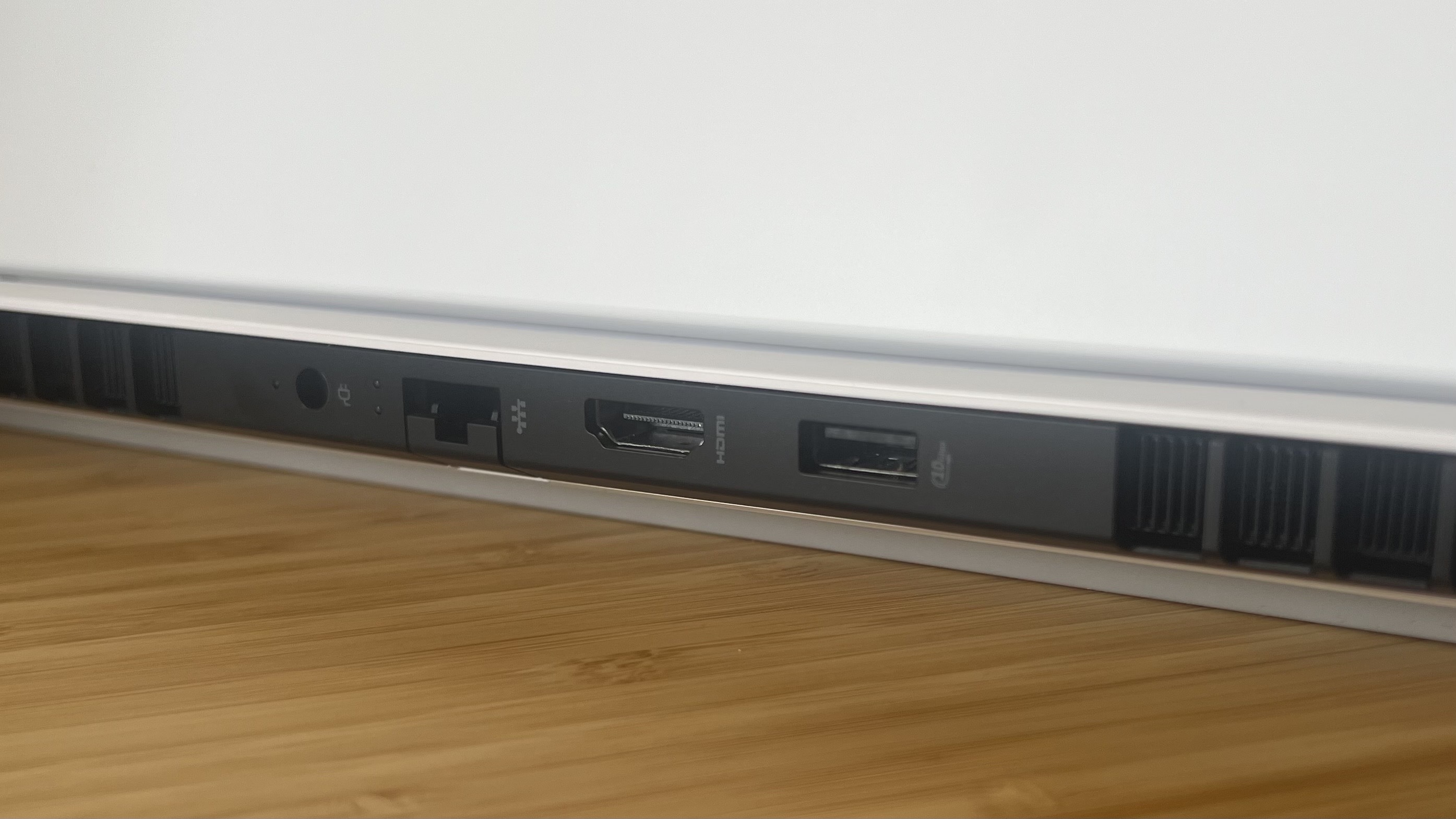
The HP Omen Max 16 is one of the few slimline 16-inch gaming laptops I've seen throwing its more permanent ports on the rear of the device. This is a big win in my books. I hate having cables sprawled out across the desk, especially when they start interfering with my mouse hand.
The Max 16 positions its power, RJ45, HDMI 2.1, and a USB-A port on the back, keeping the sides free for more ad-hoc accessories. The second USB-A port is the only connection on the right flank, with two Thunderbolt 4s (and the 3.5mm audio jack) sitting neatly on the left. If you're regularly swapping out USB-A devices, that rear placement might grow a little tiresome, but having a more accessible port on the side keeps things a little more versatile.
You do drop a Type-A connection from the Asus ROG Strix G16 and Razer Blade 16, which both offer three traditional ports, though the Omen Max doubles the number of Thunderbolt options compared to Asus's devices. Razer builds off an AMD base, so these are swapped for USB-4.
If you're looking to wire in your internet, it's also worth noting that both the Razer Blade 16 and Asus ROG Zephyrus G16 sacrifice the RJ45 present on the HP Omen Max 16, but trade in an SD card reader in its place.
While the HP Omen Max 16 does offer some rear ports, Alienware's Area-51 model doubles down on this more permanent placement. You'll find a full suite of USB-A and USB-C connections at the back here, making for a tidier on-desk experience overall. It also adds an extra USB-A port and upgrades you to Thunderbolt 5.
Keyboard and trackpad
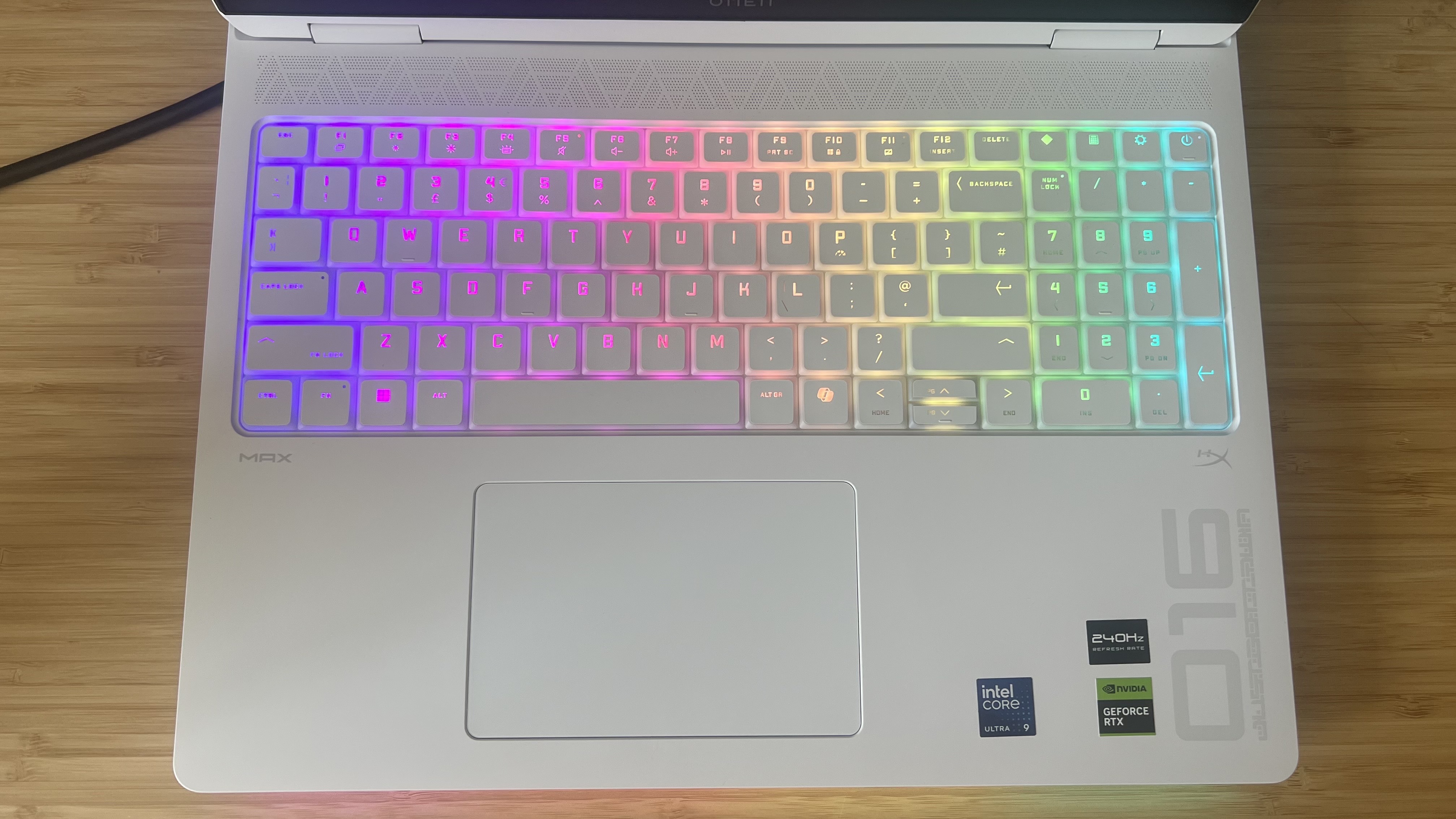
HP's keyboard looks oh so inviting with its pudding style keycaps and soft finish, but actually going hands on with the deck reveals one issue. There's a noticeable amount of flex in this deck, even when typing more casually. Thankfully, that bending doesn't equate to a spongy feel overall - in fact, there's a good amount of spring and tension in these keys. It is still a little disappointing in a more premium build, though.
You're not getting the snap of Razer's scissor switches, but it's still a satisfying feel. With plenty of action under each press, there's a good amount of space for fast repeated inputs and an actuation pressure that still feels comfortable during longer typing periods.
Functionality is a top priority here, though. The HP Omen Max 16 is one of the few 16-inch gaming laptops I've tested with a full number pad. Yes, things are a little squished on that right hand side, with half-sized up/down arrows feeling like more of a sacrifice than anything else on the deck.
The trackpad feels fantastic, with just enough tension underneath to provide a light but tactile full click. Tap gestures are picked up immediately and with a speedy response from the system, while the surface area feels smooth under the fingertips as well. Overall, it's a much better pad than the somewhat hollow version on the Asus ROG Strix G16.
Performance
I tested the HP Omen Max 16 with an RTX 5080 under the hood, but this thing behaves more like an RTX 5090 at times. At full throttle (the system's "Unleashed Mode" with full power unlocked), this machine tore through synthetic benchmarks and in-game framerates sometimes knocking far more expensive machines out of the race.
First up, 3D Mark. These are artificial GPU tests that stress various elements within the system's graphical rendering systems to spit out a final score at the end of each run. After three attempts, the HP Omen Max's final average scores are below.
The RTX 5080 inside this rig beat the RTX 5090 in the Blade 16 across both Time Spy and Fire Strike runs, though did fall slightly behind in the newer and more demanding Steel Nomad course. Still, it's well above my current overall top-pick, the Lenovo Legion Pro 7i Gen 9 (which sports a previous generation RTX 4080) and maintains its lead against similar Asus devices as well.
In-game, the HP Omen Max 16 trades places with the Razer Blade 16 a lot more, especially in FHD+ resolution. At 1920 x 1200 it's slightly beaten by Lenovo's previous juggernaut in easier runs like Shadow of the Tomb Raider, but comes out at the top of the pack across Total War: Three Kingdoms and Horizon Zero Dawn Remastered.
Things get a little spicier when we crank that resolution up to the full QHD+. Here, the HP Omen Max 16 takes the lead over the previous generation Lenovo, while also beating out the higher-specced Razer Blade 16 in all but Cyberpunk 2077 and Black Myth: Wukong.
Of course, the RTX 5080 isn't better than the RTX 5090, but it's allowed to rev its engines a little more in this iteration. The HP Omen Max 16 might not offer top-of-the-range performance in more demanding titles, but it's still leading the pack across the majority of casual games, and Horizon is far from an easy run. Of course, the RTX 50-Series also comes with 4x Multi-Frame Generation which can bump those framerates in more demanding titles should you wish to use it.
When you consider that the RTX 5090 Blade 16 I tested for these numbers comes in at $4,499.99, the Max is thriving.
A lot of that is being helped by the CPU as well. I'll eat my hat after saying this (I've not been a fan of Intel's Ultra-range processors so far), but the Core Ultra 9 275HX is a beast under this hood. It's beaten out the Intel i9-14900HX, the previous generation's gaming golden child, inside the Lenovo Legion Pro 7i and even topped the much larger Asus ROG Strix Scar 18's numbers.
For an even greater sense of just how far this CPU can go when pushed, it's second only to the massive MSI Raider A18 HX with a blinder of brain in the AMD Ryzen 9 9955HX3D in a humungous chassis.
All of that data is recorded, as always, in the HP Omen Max 16's highest performance settings. That means fan noise, and lots of it. If you want to play this way for long periods of time you'll need to crank that cooling up and things get incredibly loud.
I benchmarked both an RTX 5080 version of the HP Omen Max 16 and Alienware 16 Area-51, with some interesting results. The larger chassis size helps the Alienware model run a little faster in QHD+ resolution across more demanding games, but the HP Omen Max still held onto the top spot in the majority of in-game benchmarks. It also beat the Alienware in both Steel Nomad and Fire Strike tests, nudging slightly below in Time Spy.
Battery
The HP Omen Max 16 may thrive when connected to power, but it flounders without that cable attached. I played Doom: The Dark Ages on battery and can normally still set a gaming laptop to performance mode without being plugged in. Despite disabling 'balanced' mode from Windows itself, however, it seems that the Omen Max 16 doesn't go full into its more powerful preset without that tether. That meant I could barely make it through a mission. The whole game feels slowed to a snail's pace, with an almost laughable amount of time between frames and a grainy visual profile overall.
This is how gaming on the go used to be, but I've been impressed by more recent gaming laptops' abilities to run titles smoothly without a power connection. It's simply not an option here.
At 50% screen and 25% RGB brightness, I drained the battery to zero in just over an hour - about average for a machine of the previous generation, but still below some scores across RTX 50-Series machines.
In Balanced Mode with 50% screen brightness and 25% RGB lighting, the HP Omen Max 16 fell short of the Asus ROG Strix G16's 6.5-hour lifespan, coming in at just under four hours.
The Alienware Area-51 did perform better than the HP Omen Max 16 when the cable was unplugged, but it drained its battery much faster only coming in at 20 minutes game time.
Should you buy the HP Omen Max 16?

Yes, it's got some battery woes and there's a little flexing to the main keyboard but ultimately the HP Omen Max 16 is the most well-rounded gaming laptop I've tested so far. With a comfortable, sleek, portable design but performance metrics that push larger chassis out the way, the Max is a must-see machine. It's at a similar price to slimmer, more OLED-friendly devices, and its overall productivity experience isn't going to match that of the Razer Blade 16. It is, however, far more likely to drop that MSRP (and has been regularly over the last couple of months). That makes it my new go-to for anyone after a future-proofed rig for a value-packed price/performance ratio - as long as you keep it plugged in.
How I tested the HP Omen Max 16
I used the HP Omen Max 16 for two weeks before completing this review, while also testing directly against the Asus ROG Strix G16. I performed three sets of 3D Mark graphical benchmarks, running Time Spy, Fire Strike, and Steel Nomad three times each and taking an average result as each final score. I also tested the rig in in-game benchmark scenarios across Shadow of the Tomb Raider, Total War: Three Kingdoms, Horizon Forbidden West, Cyberpunk 2077, and Black Myth Wukong. Each of these tests were also run three times, across 'High' and 'Highest' settings in FHD+ and QHD+ resolutions. I then performed separate DLSS Frame Generation tests in Cyberpunk 2077.
All performance benchmarks were recorded in the system's 'Unleashed' power mode, with full available wattage supplied.
For more information on how we test gaming laptops, check out the full GamesRadar+ Hardware Policy.
I'm also hunting down the best Alienware laptops to buy right now - or check out the best gaming handhelds and best gaming PCs for different ways to play.

Managing Editor of Hardware at GamesRadar+, I originally landed in hardware at our sister site TechRadar before moving over to GamesRadar. In between, I've written for Tom’s Guide, Wireframe, The Indie Game Website and That Video Game Blog, covering everything from the PS5 launch to the Apple Pencil. Now, i'm focused on Nintendo Switch, gaming laptops (and the keyboards, headsets and mice that come with them), PS5, and trying to find the perfect projector.
You must confirm your public display name before commenting
Please logout and then login again, you will then be prompted to enter your display name.



